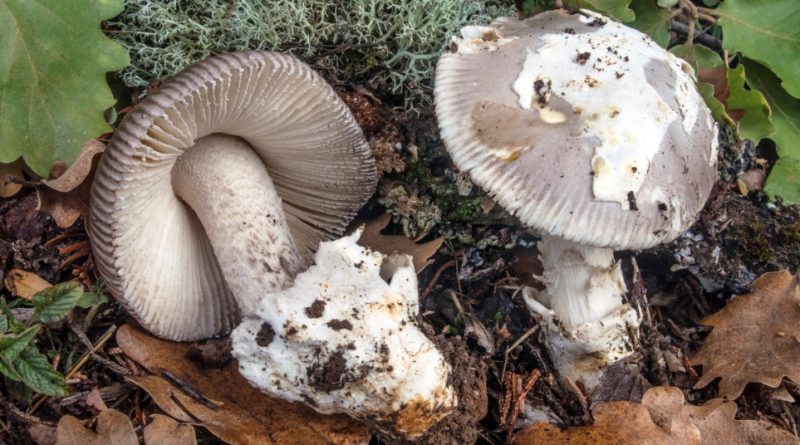Amanita mairei
Amanita mairei
The Maire’s Amanita (Amanita mairei Foley, 1949) is a mushroom belonging to the Amanitaceae family.
Systematic –
From a systematic point of view it belongs to:
Eukaryota domain,
Fungi Kingdom,
Division Basidiomycota,
Subdivision Agaricomycotina,
Class Agaricomycetes,
Subclass Agaricomycetidae,
Order Agaricales,
Amanitaceae family,
Genus Amanita,
Species A. mairei.
The terms are synonymous:
– Amanita crassipes Coccia & Migl.;
– Amanita griseocastanea Coccia & Migl.;
– Amanita luteovergens Coccia & Migl.;
– Amanita mairei var. amplivolvata Contu.
Etymology –
The term Amanita comes from the Greek Ἀμανὶτης, Amanitos, mushroom of Mount Amano, from Ἄμανος, Amanos, i.e. Amano, a chain of mountains between Cilicia and Syria, in Asian Turkey, where this species seems to have been abundant in ancient times.
The specific epithet mairei was given in honor of the botanist Renè Maire (1878-1949) graduated in Natural Sciences, assistant at the University of Nancy until 1911, the year in which he moved to Algeria where he obtained the chair of botany and where in 1916 he obtained a further degree in medicine. From 1930 he directed the Algerian Botanical Service. He was an honorary member of the S.M.F. to which he had been a member since 1899.
Geographic Distribution and Habitat –
Amanita mairei is a basidiomycete native to Eurasia and North America.
Its habitat is that of broad-leaved woods but also of the maritime pine forests of the Mediterranean, with preference for the latter, on terrain of different nature, where, being a thermophilic species, it grows from late spring to early autumn.
Recognition –
The Amanita mairei can be recognized by its cap streaked at the edge. This has dimensions of 5-10 cm, first hemispherical then convex, flat at maturity, rarely or almost never, in mature specimens it can be more or less umbonate, with a clearly striated margin. The color is ash grey, silvery grey, more or less dark, glabrous, smooth, naked or often with large plaques of general veil.
The lamellae are dense, free to adnate, interspersed with lamellulae, white with a tendency to become greyish with age and with pruinous lamellar thread.
The stem is variable in color from white to grey, hollow, and with an absent ring. It has dimensions of 5-12 × 1-2 cm; fragile, slender, cylindrical or subcylindrical, flared towards the apex; widened downwards, with a surface covered more or less by fine flakes that draw a zebra pattern, colorless or slightly greyish.
The ring is missing.
The volva is white, membranous, thick, persistent and sheathing in the basal part, open and flared.
The meat is of an immutable whitish colour, rather tender, fragile, more or less thick, with little significant flavor and smell and no particularity.
Under the microscope, hyaline, non-amyloid, ellipsoidal, guttulate spores are observed. The spores measure (9.5-) 11.0 – 14.0 (-17.5) × (6.6-) 7.1 – 10.0 (-11.5) µm.
General veil essentially formed by filamentous hyphae with very rare spherocytes measuring 30-60 µm.
Chemical reactions: non-amyloid spores in contact with Melzer’s reagent.
Cultivation –
The Amanita mairei, although edible after cooking, is not a cultivated mushroom.
Customs and Traditions –
The Amanita mairei is a mushroom which, due to its variability, both in its shape and in its pileic colours, is considered by many authors to be part of a collective species including some taxa such as: Amanita argentea Huijsman, Amanita supravolvata Lanne, Amanita huijsmanii F. Massart & Rouzeau.
The different opinions, as usual, are little or not at all convergent, however in 1994 Rodham E. Tulloss (Type studies in Amanita section Vaginatae I: Some taxa described in this Century (studies 1-23) with notes on description of spores and refractive hyphae in Amanita. Mycotaxon 52: 305-396) reiterated the validity of the species rank for the above-mentioned species.
In general it is a mushroom that is not always easy to recognize due to its similarity to A. vaginata, with which it is often confused.
However, it stands out above all for its more robust structure, for the cap that is always hemispherical in shape, for the volva that sheaths downwards and flares upwards, which gives it the typical tulip shape.
Furthermore, its variability is discussed as some authors consider some ecological forms to be varieties which for others are species defined as real taxons. Between these:
– Amanita cistetorum Contu & Pacioni: separate species but it would seem more like an ecological variety of A. mairei, cistus habitat, smaller, darker.
– Amanita mairei Foley fo. supravolvata (Lanne) Romagnesi = Amanita supravolvata Lenne: different ecological form with habitat on sand.
– Amanita mairei Foley var. bertaultii (Contu) Contu: growing in coastal pine forests (Pinus pinaster), it has a volva that is always sheathing but more fragile.
A. mairei is a ubiquitous species, which can be found in the period from spring to summer-early autumn, both in broad-leaved and coniferous forests, although uncommon.
It is an edible mushroom, after cooking at 70°-80° for at least 20 minutes, this is because it contains thermolabile toxic substances (hemolysins), which dissolve at these temperatures.
Preparation Method –
The Amanita mairei is an edible and good mushroom but only after adequate cooking, like all Amanitas without ring.
When raw it is poisonous.
Guido Bissanti
Sources
– Wikipedia, the free encyclopedia.
– GBIF, the Global Biodiversity Information Facility.
– Cetto B., 2008. Mushrooms from life, Saturnia, Trento.
– Pignatti S., 1982. Flora d’Italia, Edagricole, Bologna.
– Conti F., Abbate G., Alessandrini A., Blasi C. (ed.), 2005. An annotated checklist of the Italian vascular flora, Palombi Editore.
Photo source:
– https://inaturalist-open-data.s3.amazonaws.com/photos/175694012/original.jpg
– http://mediaphoto.mnhn.fr/media/14431989944775HJIOn3TsQQmjmuC
Attention: Pharmaceutical applications and food uses are indicated for informational purposes only, they do not represent in any way a medical prescription; we therefore decline any responsibility for their use for healing, aesthetic or food purposes.


